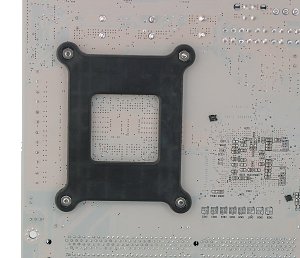Soltek
85ERV2 VIA P4X400 Based Mainboard
|
The board is almost identical to the previous model on the same chipset - 85ERV
and differs only in stepping and in surrounding components of the memory modules,
which let us work correctly (though not very efficiently) with PC3200(DDR400)
memory.
Accessories: - Package of the standard design;
-
Documentation: user manual, brief installation manual, software description -
all in English;
- Cables: FDD, ATA66/100/133;
- 2 CDs
containing:
- drivers;
- several system monitoring
utilities;
- Adobe Acrobat Reader;
- Boostek;
-
PC-cillin 2002;
- Virtual Drive 7;
- RestoreIT! 3 Lite;
-
PartitionMagic 6 SE;
- DriveImage 4.

The layout doesn't shine: audio-ins are in front of the PCI, and the IDE and
FDD are behind them, an inserted video card will lock memory modules, and cables
connected to the power supply connectors will worsen ventilation. It's not difficult
to reach jumpers when the board is already installed. Their functions are not
shown on the textolite. The 3-channel switching voltage regulator incorporates
7 capacitors of 2200 uF and 3 of 1500 uF. The following controllers are
integrated: - audio controller based on the chipset's capabilities
and Avance Logic ALC650 AC'97 codec supporting 5.1 audio systems and having connectors
for front audio outputs and for SPDIF.
Thanks to the ITE IT8705F
I/O controller the board supports (and have connectors) a SmartCard Reader.
On the back you can see a plate that prevents twisting of the textolite in
case of powerful CPU coolers.

Non-unsoldered
connectors: network controller and RJ45 connector. The system monitoring
is supported by the ITE IT8712F-A chip. What is controlled: - processor
voltage, memory, +3.3, +-5 and +-12 V, VBAT and +5 V Standby
- speed of 2
fans;
- temperatures of the processor (a built-in sensor) and the
board (a built-in sensor) and an external sensor connected to the board.
There
are 2 connectors for adjustable and 2 for unadjustable connection of fans.
Brief characteristics of the board: memory slots - 3 DDR SDRAM; expansion
slots - AGP/ 6 PCI; I/O ports - 2 COM/ LPT/ 2 PS/2/ 6 USB 2.0; dimensions - 305x220
mm. Adjustment can be carried out with:
| jumpers and switches |
Jumper to clear up the CMOS |
|
| Jumper enabling BIOS write protection |
|
| Jumper to set a FSB frequency |
Auto, 100 è 133 MHz |
| BIOS based on AMI's 3.31a |
Setup of memory timings |
+ |
CAS Latency, Bank Interleave, Burst Length, Command Rate |
| Setup of memory frequency |
+ |
Auto, DDR200, DDR266, DDR333, DDR400 |
| Setup of AGP bus |
+ |
|
| Setup of PCI bus |
+ |
|
| Changeable scaler of AGP and PCI buses |
- |
|
| Manual assignment of interrupts |
+ |
|
| Changeable FSB frequency |
+ |
100-200 MHz in 1MHz steps |
| Changeable CPU multiplier |
+ |
x8-x32 |
| Changeable core voltage |
+ |
1.1-1.85V in 0.025 V steps |
| Changeable memory voltage |
+ |
2.5-2.8 V in 0.1V steps |
| Changeable chipset voltage |
- |
|
| Changeable AGP bus voltage |
+ |
1.5-1.8V in 0.1V steps |
We used the BIOS AJ1.4 as the latest available
version. The board is a bit more efficient than its predecessor and works
stably with PC3200 memory, but it's inferior to the Intel-based solutions and
can't boast of rich functionality. It can be of interest for those who want to
save on a mainboard and overclock the system. Test results:
Write a comment below. No registration needed!
|
|


